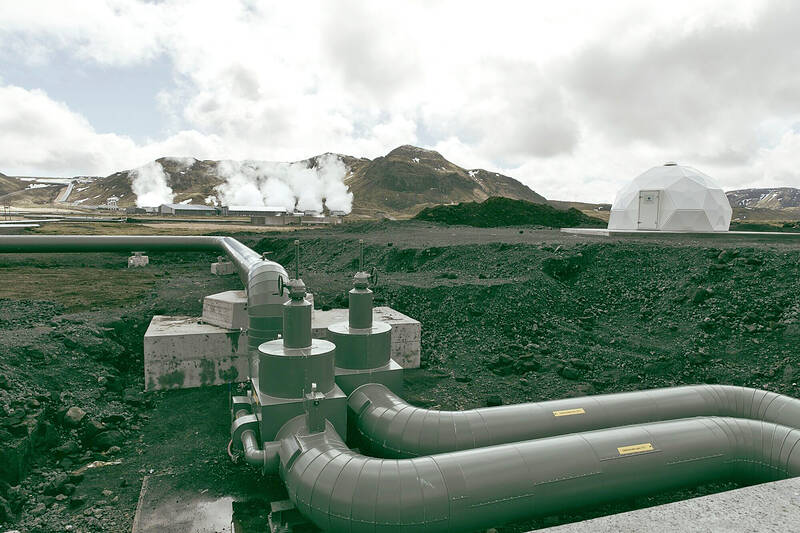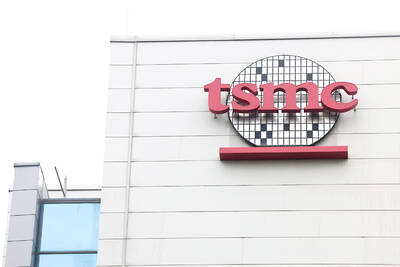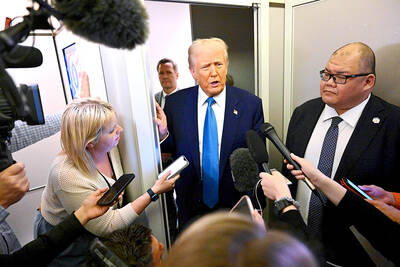With Mammoth’s 72 industrial fans, Swiss start-up Climeworks AG intends to suck 36,000 tonnes of carbon dioxide from the air annually to bury underground, vying to prove the technology has a place in the fight against global warming.
Mammoth, the largest carbon dioxide capture and storage facility of its kind, launched operations this week on a dormant volcano in Iceland. It adds significant capacity to the Climework’s first project, Orca, which also sucks the primary greenhouse gas fueling climate change from the atmosphere.
Just 50km from an active volcano, the seemingly risky site was chosen for its proximity to the Hellisheidi geothermal energy plant necessary to power the facility’s fans and heat chemical filters to extract carbon dioxide with water vapor.

Photo: Bloomberg
The carbon is then separated from the steam and compressed in a hangar where huge pipes crisscross.
Finally, the gas is dissolved in water and pumped underground with a “sort of giant SodaStream,” said Bergur Sigfusson, chief system development officer for Carbfix, which developed the process.
A well, drilled under a futuristic-looking dome, injects the water 700m down into volcanic basalt that makes up 90 percent of Iceland’s subsoil, where it reacts with the magnesium, calcium and iron in the rock to form crystals — solid reservoirs of carbon dioxide.
For the world to achieve “carbon neutrality” by 2050, “we should be removing something like 6 to 16 billion tonnes of CO2 per year from the air,” said Jan Wurzbacher, cofounder and cochief of Climeworks at the inauguration of the first 12 container fans at Mammoth.
“I quite strongly believe that a large share of these ... need to be covered by technical solutions,” he said.
“Not we alone, not as a single company. Others should do that as well,” he added, setting his start-up of 520 employees the goal of surpassing millions of tonnes by 2030 and approaching a billion by 2050.
Three years after opening Orca, Climeworks would increase capacity from 4,000 to 40,000 tonnes of carbon dioxide captured once Mammoth is at full capacity — but that represents just seconds of the world’s actual emissions.
According to the Intergovernmental Panel on Climate Change, the UN’s climate expert body, carbon removal technologies would be necessary to meet the targets of the 2015 Paris Agreement — but major reductions of emissions is the priority.
The role of direct air capture with carbon storage remains minor in the various climate models due to its high price, and its deployment at a large scale depends on the availability of renewable energy.
Climeworks is a pioneer with the two first plants in the world to have surpassed the pilot stage at a cost of about US$1,000 per tonne captured. Wurzbacher expects the cost to decline to US$300 in 2030.
More than 20 new infrastructure projects, developed by various players and combining direct capture and storage, should be operational worldwide by 2030 with a capacity of about 10 million tonnes.
“We need probably around US$10 billion to proceed over the next decade to deploy our assets” in the US, Canada, Norway, Oman and Kenya, said Christoph Gebald, Climeworks cofounder and cochief, 10 times what the company has already raised.
“When I’m standing now at Orca I think: ‘Oh this looks like a little bit like Lego bricks.’ It’s a tiny thing compared to Mammoth,” Wurzbacher said.
Lego bought carbon credits generated by Climeworks for every tonne of carbon dioxide stored.
The credits are a way for making the solution known to the general public, said Gebald, who has not ruled out selling credits to “big polluters” as well.
Critics of the technology point to the risk of giving them “license to pollute” or diverting billions of dollars that could be better invested in readily available technology such as renewable energy or electric vehicles.
Climeworks said it targets “incompressible” emissions, after reduction.
The recipe is complex: optimize costs without competing with the growing need for renewable energy, more innovation, public and private funding, with storage infrastructure to follow.
“We are currently doing a pilot testing of using seawater for injection,” Carbfix chief scientist Sandra Osk Snaebjorndottir said.
That procedure would allow the use of seawater for the mineralization of carbon emissions, near a port built by the Icelandic company to receive carbon dioxide from other countries.

When an apartment comes up for rent in Germany’s big cities, hundreds of prospective tenants often queue down the street to view it, but the acute shortage of affordable housing is getting scant attention ahead of today’s snap general election. “Housing is one of the main problems for people, but nobody talks about it, nobody takes it seriously,” said Andreas Ibel, president of Build Europe, an association representing housing developers. Migration and the sluggish economy top the list of voters’ concerns, but analysts say housing policy fails to break through as returns on investment take time to register, making the

NOT TO WORRY: Some people are concerned funds might continue moving out of the country, but the central bank said financial account outflows are not unusual in Taiwan Taiwan’s outbound investments hit a new high last year due to investments made by contract chipmaker Taiwan Semiconductor Manufacturing Co (TSMC, 台積電) and other major manufacturers to boost global expansion, the central bank said on Thursday. The net increase in outbound investments last year reached a record US$21.05 billion, while the net increase in outbound investments by Taiwanese residents reached a record US$31.98 billion, central bank data showed. Chen Fei-wen (陳斐紋), deputy director of the central bank’s Department of Economic Research, said the increase was largely due to TSMC’s efforts to expand production in the US and Japan. Investments by Vanguard International

WARNING SHOT: The US president has threatened to impose 25 percent tariffs on all imported vehicles, and similar or higher duties on pharmaceuticals and semiconductors US President Donald Trump on Wednesday suggested that a trade deal with China was “possible” — a key target in the US leader’s tariffs policy. The US in 2020 had already agreed to “a great trade deal with China” and a new deal was “possible,” Trump said. Trump said he expected Chinese President Xi Jinping (習近平) to visit the US, without giving a timeline for his trip. Trump also said that he was talking to China about TikTok, as the US seeks to broker a sale of the popular app owned by Chinese firm ByteDance Ltd (字節跳動). Trump last week said that he had

STRUGGLING TO SURVIVE: The group is proposing a consortium of investors, with Tesla as the largest backer, and possibly a minority investment by Hon Hai Precision Nissan Motor Co shares jumped after the Financial Times reported that a high-level Japanese group has drawn up plans to seek investment from Elon Musk’s Tesla Inc to aid the struggling automaker. The group believes the electric vehicle (EV) maker is interested in acquiring Nissan’s plants in the US, the newspaper reported, citing people it did not identify. The proposal envisions a consortium of investors, with Tesla as the largest backer, but also includes the possibility of a minority investment by Hon Hai Precision Industry Co (鴻海精密) to prevent a full takeover by the Apple supplier, the report said. The group is